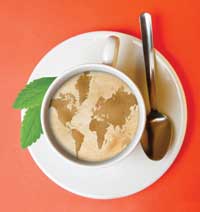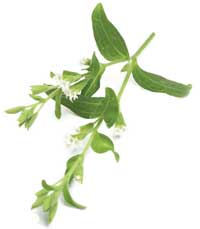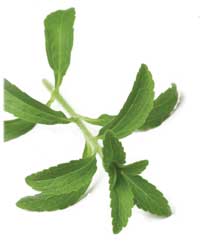Leaves of Change
With talk heightened over America's obesity problem and proposals to tax sugary drinks, opportunities are ripe for stevia, the all-natural, zero-calorie sweetener extracted from the plant Stevia rebaudiana Bertoni.
Originally Published NO June 2010

With talk heightened over America's obesity problem and proposals to tax sugary drinks, opportunities are ripe for stevia, the all-natural, zero-calorie sweetener extracted from the plant Stevia rebaudiana Bertoni.
Also opening doors for stevia are increasing regulatory approvals worldwide. In addition to such countries as Japan, China, Paraguay, Brazil, Israel, Malaysia, Taiwan, and Australia, the United States approved stevia's use in food and beverages when it deemed stevia extract rebaudioside A (Reb A) generally recognized as safe in 2008. Europe is now poised to take on stevia. In April, the European Food Safety Authority declared a range of steviol glycosides, including Reb A and stevioside, safe for use in food and beverages.
U.S. food and beverage companies have jumped at the opportunity to use stevia. The mood surrounding stevia's business potential is high, and many believe stevia could take a substantial chunk of market share for alternative sweeteners. (It has been pointed out, however, that consumer awareness of stevia is still somewhat low, but this could change as large companies such as Cargill and Pepsico/Merisant's Whole Earth Sweetener Co. have started mainstream advertising their Truvia and PureVia tabletop stevia sweeteners, respectively.)
Stevia's impact on the sweeteners market is already being felt. According to Leatherhead Food Research in its April report on the global sweeteners market, in 2009, stevia's global market value reached an estimated $215 million, up from just $10 million in 2005. In April, stevia supplier PureCircle (Oak Brook, IL) estimated the number of new market launches containing stevia in 2010 was already at 154-a 47% increase in launch activity compared with the same period in 2009.
"The popularity of stevia is…believed to be increasing as a result of growing consumer demand for more natural products, with people turning away from additives and ingredients perceived as artificial," stated Leatherhead's report. "By the middle of the next decade, it is possible that natural varieties may account for up to a quarter of the global sweeteners market."
Beverages Take the Lead
Formulators are still making headway working stevia into a range of foods and beverages. Thanks to stevia's stability to heat, light, and acid, a range of future food and beverage launches is expected to feature stevia. Stevia is also expanding its presence in markets such as tabletop sweeteners. Cargill says that according to Nielsen data, in the past year, 4.6 million households have purchased Truvia tabletop sweetener, and that in some markets, more people are now buying Truvia as a tabletop sweetener than they are purchasing Equal.)
Stevia is expected to play an especially large role in the global beverages market. In April, PureCircle reported on the success of three prominent PepsiCo brands using PureVia in their beverages. According to PureCircle, at PepsiCo's investment meeting in March, Massimo D'Amore, CEO of PepsiCo Beverages America, said that PepsiCo's Tropicana Trop50 orange juice has "the highest repeat purchase after trial than we have ever experienced-not just in juice, but across all of our beverage [portfolio]." As a result, the brand has extended the line with more flavors. Likewise, the success of PepsiCo's SoBe Lifewater PureVia-containing beverages encouraged the brand to launch new flavors. Stevia beverages now represent four out of the top five SKUs for the SoBe brand, according to Nielsen data. PepsiCo's Gatorade is also getting into the mix with its G2 Natural beverages.
Other companies are also jumping on the "naturally sweetened" train. In March, Kraft introduced its Crystal Light Pure Fitness drink mix, "naturally sweetened" with Truvia. Starbucks has also launched Zero Calorie Tazo tea, "naturally sweetened" with stevia. "More than 74% of American consumers are trying to consume less or no sugar and are looking for healthier beverage options," the brand said.
With global beverage companies on board, demand for stevia is expected to go nowhere but up. As stevia suppliers anticipate skyrocketing demand, they are also making sure that they will have enough stevia to go around.
Global Growth
Native to Paraguay, stevia was first used as a sweetener by the region's indigenous Guarani natives. Today, stevia is still grown in Paraguay, but the lion's share of stevia crop is grown in China (estimates say 80%). Elsewhere, it is grown in other South American regions, Africa, South Korea, Japan, Vietnam, Australia, and New Zealand.
"Stevia's cultivation base is becoming more diversified, and as a result, more extraction facilities are being built in numerous locations," says Michael Drinkard, senior vice president of purchasing for Cumberland Packaging Corp. (Brooklyn, NY), the maker of Stevia in the Raw tabletop sweetener.
To expand production, many stevia suppliers are looking to forge partnerships with cooperatives and other farmers, inking new supply deals. Cargill representatives say that the company is actively working with farmers and agricultural communities in Asia and South America to broaden supply.
Earlier this year, PureCircle South America announced that it had signed an agreement with the Cooperativa Colonias Unidas for the production and supply of stevia leaves in South America-a deal that was supposed to expand a crop area of 25 hectares and involve 30 cooperative partners, as well as produce more varieties of stevia.
"PureCircle has made significant investments in Paraguay and Kenya in order to diversify our supply," says Jason Hecker, group marketing director for PureCircle. "Our stevia sources from fields in 11 countries across three continents."
Also, he adds, "By investing in the Northern and Southern hemispheres, PureCircle can take advantage of counter-seasonal production. We plan to expand across Eastern and Western hemispheres to minimize our energy footprint in the supply chain. As a result, PureCircle growers will be in place in all four quadrants of the world."
Wisdom Natural Brands (Gilbert, AZ), which produces and markets SweetLeaf stevia, is now opening a new extraction facility in Chile that will expand its capacity. CEO Jim May says that he is continually traveling abroad to work with farmers throughout Latin America, as well as Asia and India, who are interested in growing stevia. "This includes farmers with a few hectares to one thousand hectares that are now being planted to grow for SweetLeaf," he says.
He adds, "The farmers have to start with seedlings and cuttings. [The plant] doesn't propagate well from seeds itself. So it's a lengthy process to get it started, to teach [farmers] how to establish their own nurseries and then to do the transplanting and so forth."

Other stevia suppliers have also been focusing on investigating new areas in which to grow crop. In May, stevia grower GLG Life Tech (Vancouver, BC, Canada) announced that it is targeting India. The company said that it had signed an agreement with Global AgriSystem Private Ltd. to begin growing and commercializing stevia in the region.
"India's agriculture base can easily adapt and handle the growing of the stevia plant, given its conducive climatic conditions," said Gokul Patnaik, chairman of Global AgriSystem.
And, it's warm, tropical climates that stevia needs.
"The best conditions for growing stevia are a warm climate, a reasonable water supply, and healthy soils," says Hecker.
"Stevia seeds require very warm temperatures of 75° to 80°F to germinate," adds JJ Betts, brand director for PureVia. "Stevia prefers full sun, except in areas where summers are very hot or dry. Stevia prefers consistent soil moisture, with no dry or soggy periods." In these conditions, stevia is considered quite a hardy plant.
Also, with the biggest market for stevia expected to be the United States (Leatherhead estimates the United States now accounts for nearly 84% of the global stevia market), might companies turn their sights towards growing stevia closer to home?
It could happen, say suppliers. May says that parts of Arizona, Southern California, Louisiana, and perhaps Texas, where conditions are warmer, might offer growing conditions sufficient for stevia. He says that there have already been "experimental" stevia farms in California.
"Several farmers here in the southwest have called me and said they would really like to grow stevia for us. I tell them that if they can do it in a way that is competitive, there's always a need," says May.
PureCircle is looking into a possible domestic stevia supply. In May, the company announced that it had signed an agreement with S&W Seed Co. (Five Points, CA), whose agronomists will work with PureCircle's stevia to try to identify the best-yielding varieties for growing in California.
"PureCircle is leading the global diversification of stevia leaf farming," said Dorn Wenninger, PureCircle's corporate vice president of supply chain. "We're committed to sourcing stevia in areas as close to our customers as possible. Our agronomists are sharing best practices from our operations in Asia, Africa, and South America with S&W Seed Co. as we work together to provide large-scale volumes of stevia leaf for American consumers."
Of course, one of the advantages that international growers have over domestic growers is labor cost. Currently, growing, harvesting, and processing stevia is an intensely hand-labor operation.
In order to grow stevia in the United States, says May, "You'd have to develop a way in which you could both plant and harvest with machinery." He says that such technology is in the works.

Getting More from the Leaf
Another way that stevia suppliers are looking to expand stevia supply is by improving the sweetness yield of the stevia leaf itself. The mission to develop higher-yield leaves-that is, stevia leaves that, for instance, contain more Reb A so that companies can extract more Reb A from fewer leaves-is one that's being worked on by suppliers such as PureCircle.
In April, PureCircle announced that it is working with Michigan State University on research and breeding to create varieties of stevia that contain "dramatically higher levels of sweetness" in the leaf, as well as other agricultural improvements. The research will also focus on steviol glycosides beyond Reb A, says the company.
Advances such as a hardier, higher-yield plant would also improve the economics for both farmers and customers, said Magomet Malsagov, PureCircle's CEO. And this is the hope of many-that agronomy advances will help bring down prices for stevia, further expanding its market reach.
Meanwhile, stevia plants already offer high-yield harvesting, which is a reason that farmers, both international and domestic, are eager to get into the stevia-growing business. One of the benefits of stevia is that in order to harvest it, you don't need to kill the whole plant. Rather, "You cut everything off a few inches above the ground level, and in three months, the plant is ready to be harvested again," says May. "If you do everything right, the plant will live for five to seven years, producing every 90 days or so."
Thus, the same stevia plant can be harvested multiple times a year, which means a multiyear cash crop.
However, May cautions, one problem he has seen in developing higher-yield plants is that sometimes, plants with higher amounts of Reb A and other glycosides are more difficult to transplant, to take from the nursery to the field. "Sometimes, they don't respond to the new soil conditions," he says. "They're just not robust."
Also, adds PureCircle's Hecker, while stevia can be grown in conditions that aren't ideal, if they are, "the plant yield will be less, as it may not be able to be harvested as frequently."
However, May adds, "Those things will all be overcome. We have brilliant agronomists in this country and all over the world who will overcome the problems. But it takes time."
Are Suppliers Ready?
So, are suppliers ready for a spike in stevia demand? Many say they have been prepared for growing demand all along.
"From the very beginning, one of the things we assured our customers was that we would be able to supply as demand expands," says Cecilia McCollum, executive vice president of Blue California (Rancho Santa Margarita, CA), supplier of the Good&Sweet Reb A brand.
From the marketer's end, JJ Betts of PureVia says, "There is a risk of Reb A shortage if other countries approve Reb A quickly, and if sales growth in the United States remains strong." However, he says that PureVia's partnership with a suppler like PureCircle, which is prepared for growth, protects the brand from such a shortage.
"PureCircle has spent the last seven years investing in stevia leaves and building its infrastructure in anticipation of consumer demand…we are prepared for rapid growth in the stevia market as a result of our proven ability to expand rapidly," says Hecker. "Our extraction facility is now producing four times as much volume than just two years ago. Our strategy for leaf has been to increase the inventory and quality of leaf."
As stevia supply becomes more diversified and sourced from stevia farms and facilities all over the globe, companies are now focusing more than ever before on quality control. "As supply becomes more global, the supply chain can become convoluted," says McCollum. She warns marketers to audit their stevia to ensure that they know where it's coming from-and "don't just look at documents," she says.
"Stevia is not difficult to produce, but it is difficult to produce consistently at a high quality in large quantities," says Hecker.
"Like any botanical, there is the potential for adulteration, but a good-quality manufacturer will test for contamination and adulteration for all the ingredients they receive," says Michael Lelah, technical director for NOW Foods. (The company's stevia is one of the few organic stevia brands on the market today.) Lelah says that applying the quality-control standards that you would to any botanical is key, such as the microbial and heavy-metal-contamination limits set by the American Herbal Products Association.
Most agree that while it is stevia's time to shine, it's also a make-or-break time for a sweetener that is being tried by many customers for the first time.
"It's a delicate market, and thus, a crucial time," says McCollum. "When consumers taste the product for the first time, there has to be quality there."
"Ensuring high-quality products is essential to prevent a backlash by consumers," agrees Lelah.,/P>
With a potential $2 billion global market at stake (Mintel estimates that stevia sales could exceed this number by the end of 2011), now is the time for stevia to make a sweet impression.
The Nutritional Outlook Podcast Episode 39: Nutritional Outlook's Ingredients to Watch in 2025
February 25th 2025In this episode, Nutritional Outlook interviews Scott Dicker, market insights director from market researcher SPINS, about ingredients and product categories nutraceutical and nutrition product manufacturers should watch in 2025.










